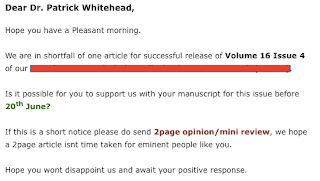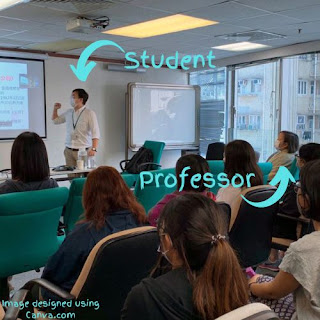Beware the vanity and predatory publishers!
About once a week I receive an offer to publish an article or review or essay or study or chapter in an unknown academic journal. You'll find a few of these offers throughout this article. The offers are always dripping with compliments and genuflection. They are also often dripping with typos and other errors, such as a misspelling of my name ("Dr. M. Whitehead Patrick").
Once the warmth from the kind words has dissipated, I check out the journal website to see if there is an Article Processing Charge (APC). This is the cost to the author for having their article published. In the hundreds of such requests I have received, every single journal has an APC of at least $500 (US). Sometimes this number is as high as $2500 (US).
Now, not all APCs are money-making schemes. I am on the editorial board of a philosophy journal called Indo-Pacific Journal of Phenomenology. The last time I published with them, the APC was around $500 (US). This paid the salary of the editor, who was a very kind and helpful person, along with the copy-editor, proof-reader, and production crew. When publishing with IPJP I grew a lot as a writer and scholar. The feedback I got was encouraging and helpful. I think I had around six revisions. Of course all of this help came before my paper was accepted for publication and the fee became due. This meant that I could have benefited from all of this help and then taken my paper elsewhere.
But this is not what happens at vanity presses or predatory presses.
Predatory Presses: Pay To Publish
Many colleges and universities have
a minimum scholarship expectation for all faculty who wish to be given tenure. Some schools have these expectations before they will interview a prospective faculty candidate! It is also my understanding that non US universities, such as those in East Asia, require that their faculty publish in journals that use the English language. In other words, there is a huge demand for scholarly journals in English. Enter: predatory presses.
A predatory press looks and sounds and acts like an academic press, but they have a simple goal: to generate maximum publications at minimum time expenditure, which they can accomplish for a fee. Predatory presses promise a very short turnaround from article submission to publication. Sometimes as little as 1-2 weeks. The e-mail at the top of this article was a request for me to submit an essay that would be published in 2 weeks.
In order for it to satisfy the definition of "refereed journal," a predatory press must give the impression of peer review. They do this by automated emails to solicit reviewers. I know this because I also get 1-2 requests to review articles every week. I am promised a discount on a future APC for being a reviewer. I will agree to review these if I am genuinely interested in the topic. During the pandemic, there were a lot of interesting studies on healthcare worker burnout. Some of these articles were quite good. Others were terrible. Regardless of my review, which I was always pressured to finish as quickly as possible, the article would appear in print. This is a good indication that the journal is not really interested in what the review process accomplishes, only that it has occurred.
In the end, the scholar gets their publication and the press gets their $2500 (US). It's a basic transaction. I'm not so sure, however, that tenure review committees are taken in by journal titles such as International Journal of Yoga, Golf, and Neuroscience.
Vanity Presses: Copyright in Exchange for Publication
As soon as my dissertation title hit the SCOPUS catalogs, I began getting offers from academic-sounding presses to publish my book. They were willing to take my unpublished manuscript, slap a barcode on it, and list it on Amazon for $200 (US).
While I saw through the hoax initially, I eventually fell prey to a vanity press. I knew what was going on when it happened, but that doesn't mean I'm happy about my decision. Eager to get a second book published as quickly as possible (which is a terrible idea), I scouted nonfiction presses that seemed to publish a wide variety of subjects. I wasn't interested in feedback or in tightening up my argument or in reaching a huge audience. I wanted a second book publication, because I believed I was the Steven Tyler of theoretical psychology.
Vanity presses handle copy editing (purportedly), formatting, cover design, and so on. In exchange, they own the copyright and take all of the profit. I suspect that many of these publishers make their money selling the books back to the author. (I never did buy a copy of my vanity book). I once wrote a chapter for an edited volume, and the publisher offered me the book at a discounted rate (still $75 US!).
Think of vanity presses as self-publishing with a trade-off. Neither publication format offers editorial feedback. Neither comes with the support or reputation of an academic or university press. The difference is that self-published authors have to figure out their own formatting and cover design, but in exchange for this the keep their copyright and all profits. Vanity press authors don't have to bother with formatting or cover design, but the also don't have to bother with making money.
A Chilling Look Inside the Machine
I got an opportunity to peak behind the curtain of a giant e-publishing mill. It was one of the SAGE-Open journals, which had published a lot of great authors. There was an article I was asked to review that was on a topic of a book I had just written, so I accepted. But I didn't realize that I was being asked to play the role of editor. The abstract was nonsense, so I gave the article a desk rejection from the editor's chair. The article bounced around to a dozen other editors and back to me, and I didn't have the option to reject it. I accidentally stumbled onto a screen that listed the journey the article had taken. It had been reviewed and rejected by hundreds of people, all of whom were selected by publication keyword. The process had been on autopilot. There was no editor at the helm, just a series of article editors who had minimal editorial autonomy.
At least it was possible for an article to be rejected, at least temporarily. It would have been much easier for me to have accepted the article rather than go and collect a bunch of "nos" from people who knew something about the topic.
SAGE-Open journals have APCs. They are not ludicruous, but they are something. Considering the thousands of articles that can be handled by the automated system, I imagine that SAGE Publications is doing very well in all of this.




Comments
Post a Comment